Lecture #21: Symbols of Place and Nation
A guest lecture given by Ben Kasten
Suggestions for Further Readings:
Niagara Falls:
Pierre Barton, Niagara: A History of the Falls (Toronto: McClelland and Stewart, 1992).
Karen Dubinsky, The Second Greatest Disappointment: Honeymooning and Tourism at Niagara Falls (Toronto: Between the Lines, 1999).
Patrick McGreevy, Imagining Niagara: The Meaning and Making of Niagara Falls (Amherst: University of Massachusetts Press, 1994).
Elizabeth McKinsey, Niagara Falls: Icon of the American Sublime (New York: Cambridge University Press, 1985).
Ben Kasten, “Damming God? Making Sense of the Plan to Fix Niagara Falls,” Edge Effects (digital magazine of the UW Center for Culture, History, and the Environment [CHE]), March 22, 2016. http://edgeeffects.net/niagara-falls/
Lincoln Memorial:
Kate Masur, An Example for All the Land: Emancipation and the Struggle Over Equality in Washington, D.C. (Chapel Hill: University of North Carolina Press, 2010).
Kirk Savage, Monument Wars: Washington, D.C., the National Mall, and the Transformation of the Memorial Landscape (Berkeley: University of California Press, 2009).
Christopher Thomas, The Lincoln Memorial and American Life (Princeton, N.J.: Princeton University Press, 2002).
I. Introduction
This is a lecture about landscapes that have become American national symbols. Let me flag that this is an unusual lecture, because it is not easy to fit into a particular period. The stories I'm going to tell start well before the 19th century and continue onto the 20th century. Also, this lecture puts ideas at its center; in other lectures in this class, we've talked about ideas within the frame of technological or economic change. But for this lecture, we're going to place ideas front and center.
In the last lecture we saw the grain elevators in Chicago, the logging roads in Wisconsin, the 19th-century plains farmstead, and rafts on the Mississippi River. We talked about these places as elements of the North American landscape. I want to notice something for you: that the title of this course is singular, landscape rather than landscapes. I want to propose that the course title works as a riddle: how does it not strike us as immediately ridiculous to talk about the American landscape? To answer this question, I want to suggest that we are talking about the intersection of places and ideas. Certain places have come to symbolize certain ideas about what the nation is and what it means.
To say that slightly differently: Contests over what America means can be read in the landscape, in past conflicts over what the landscape should look like.
I want to linger with the concept of a symbol for a second. Let's try a thought experiment: In the next 30 seconds, come up with a list of three places that you think of as American national symbols. [Class responds in a brainstorm: White House, Bryce Canyon, Mount Rushmore, Statue of Liberty. Ben notices that no one in the class had identical lists, but many overlaps.]
A case could be made for any of the landscapes you shouted out just now. What's suprising is that though there were many overlaps between lists, there's no clear rubric for how to decide what constitutes a national symbol. How can it be that certain places seem to hold such a powerful position in our imaginations when we think about what kind of landscape symbolizes America, despite there being no clear rubric for what criteria we should decide by? This is a reminder of how we situate ourselves in the world.
I want to notice something in the places that you shared. We could plausibly group places into broad categories of natural places and and built places: Bryce Canyon and the Statue of Liberty seem pretty emblematic of those two groups. However, one of the takeaways of this lecture is that the places we think of as "natural” spaces are also constructed to reflect certain human ideals; conversely, places we think of as “built” still contain within them a lot of non-human nature. My goal in this lecture is not disenchantment, to remove the symbolic power of icons of America: the opposite, in fact. By historicizing important symbolic spaces, my goal is to push us to see them with fresh eyes. In this lecture, we'll talk about two such places: Niagara Falls and the Lincoln Memorial.
II. Niagara Falls
Niagara Falls was arguably the most important landscape in the U.S. in the middle of the 19th century. It is certainly a place that registers today as a must-see spot, particularly for the Eastern U.S. Its located in Western New York between Lake Erie and Lake Ontario is important to keep track of because that location pushes us to remember how much water is flowing over those falls. All of the water from the upper four Great Lakes is flowing over those falls. In this class, we've thought about the Great Lakes and St. Lawrence rivershed as a trade corridor and an economically important region. Today, we'll move away from this economic frame: I'm going to talk about how and when Niagara Falls became a symbol of the U.S. nation. Niagara Falls is the result of a geological formation called the Niagara Escarpment. It is part of the same geological formation that runs through parts of Wisconsin: you can see the same kind of dolomite striations in southwestern Wisconsin as in Niagara. Erosion means that the position of Niagara Falls has been changing over the past 10,000 years. The falls continue to recede by 1-3 feet every year.
The first written account of Niagara Falls was authored by Father Louis Hennepin (1626-1705), who helped to cement in the minds of a European audience an image of Niagara Falls as a terrifying and staggering landscape. Hennepin was not the only visitor awestruck by Niagara: even the Swedish naturalist Pehr Kalm (1716-1779), who strove for scientific detachment in his descriptions, concluded this about the place: "you cannot see it without being quite terrified,” and it was a place “that would make your hair stand on end." This brings us to the riddle: if fear and awe were the dominant ways that Europeans were thinking about Niagara Falls in the 18th century, why would it start to become a popular spot for tourism by the early 19th century?
The answer lies in Romanticism: an intellectual tradition exemplified by the philosopher Edmund Burke in his 1757 treatise, A Philosophical Enquiry into the Origin of our Ideas of the Sublime and Beautiful. Romantic ideas about wild nature as a place to commune with God—wild, terrifying, filling one with awe—motivated Americans to visit Niagara Falls. Edmund Burke's notion of the sublime helped Niagara become a place associated with the sublime, a place where individuals could find God in nature.
One of the early tourists who visited Niagara Falls was John James Audubon (1785-1851). Audobon wrote in his diary: "All trembling, I reached the Falls of Niagara, and oh, what a scene! my blood shudders still, although I am not a coward, at the grandeur of the Creator's power." Audubon predicted that the place would never be painted—but painted it was, and many times over: by the American landscape painter Thomas Cole, by Thomas Davies, and by Frederic Edwin Church.
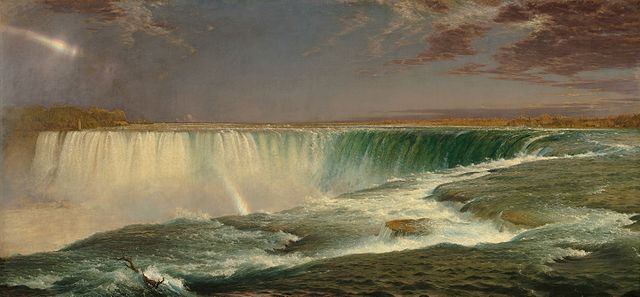 Frederic Edwin Church, Niagara, 1857
Frederic Edwin Church, Niagara, 1857
These images of sublime Niagara Falls point us to why Niagara Falls was crucial to the country as a new republic. The U.S. in the 19th century, unlike its European counterparts, did not have century-old buildings or national monuments to point to as evidence of national greatness. So instead, natural symbols like Niagara Falls become crucial to the new nation.
Here's another puzzle: how do we get from Romantic paintings of Niagara Falls as wild, non-human nature to its status as a wildly popular spot for newlyweds to take their honeymoon photographs—and a source of disappointment (in Oscar Wilde's words) rather than a source of awe? How did this change in ideas about Niagara Falls happen?
One answer is in transportation technology. In 1800, it took about 1 week to get from New York City to Niagara Falls. By 1830, with the opening of the Erie Canal, it took 3-4 days. By 1857, with the advent of the railroad, getting to Niagara Falls took just a few hours from New York. So railroads, as in so many of the changes we've seen this semester, rapidly diminished the travel time to Niagara, making it a more accessible tourist destination.
By the early 1900s, honeymoon photographs become a normal way to experience Niagara Falls. Notice in these photographs, that the space has been very shaped by human decisions: specifically construct vantage points, guard rails, a sense of a "proper way" to see the site, and a sense of separation from the sublime. Another feature that developed as the tourist industry developed was a daredevil industry around Niagara Falls. The idea of the sublime—danger and risk—was what we could call commercialized, turned into spectacle for American tourists who started to visit. Spectacle took some spectacular forms: in the form of tightrope walking over the Falls (Charles Blondin, 1859), or cooking an egg on a tightrope over the Falls (Great Farini), or going over the Falls in a barrel (Annie Taylor, 1901), etc. Spectacle and daredevilry were byproducts of the fact that by the end of the 19th century, it had become almost a form of civic duty to visit a place like Niagara Falls—it was a place one was supposed to visit as a typical American citizen.
So we have Romanticism turning into spectable, bringing with it crowds of honeymooners. But Niagara Falls was not just romantic wilderness or tourist destination. Some individuals in the 19th century and especially early 20th century noticed it as a economic resource, particularly for its hydropower. If the tourism story is about American romanticism and sensationalism, hydropower reflects another strand of American culture: corporate capitalism, technological progress, and modernity. All of these features were coming together to create a sense of what it meant for America to be modern in the late 19th century.
The first mill at Niagara falls was a small sawmill. One of the first hydropower companies was founded in the 1850s, and by 1900 there was a flourishing mill district just a few miles downstream from where Annie Taylor pulled herself out of the water in her barrel. There's a longer and fascinating story here about a competition between Thomas Edison, a proponent of direct current, and Nikola Tesla and George Westinghouse, proponents of alternating currents, that takes place in Niagara, and I only have time to gesture at it. Niagara Power Station #1, a construction of George Westinghouse in 1895, revolutionized the way that we would use electricity in this country by solidifying the use of alternating current (AC) over direct current (DC). But even in this power story, harnessing Niagara Falls in a technological sense was not completely eclipsing the cultural meaning of the falls: George Westinghouse and his wife Marguerite had their picture taken in front of the falls in the 1890s.
By the early 1900s, controvery had emerged over how to visit the Falls, as symbolized by this 1906 image from Puck magazine: "Save Niagara Falls—from this." In this image, we see the place completely overtaken by tourist demand. Notice the questions pointed to in this image: How should one balance all of these visions for what the Falls should be: a source of natural beauty, a tourist destination for the masses, and a source of energy?
 Puck Cartoon, "Save Niagara Falls--From This"
Puck Cartoon, "Save Niagara Falls--From This"
But perhaps critics were worrying about the wrong threat. Here's a reminder of the power of the non-human mixed with human ideas about nature in a place like Niagara: this 1969 image shows the Army Corps of Engineers "shutting off" Niagara Falls—diverting all water flow—for a period of five months so they could understand how erosion was affecting the waterfall. This image looks strange to us because we are inheritors of Romantic ideals of Niagara Falls as a wild non-human space and yet, as we've seen, it is a hybrid of human ideals about the nation and geological forces.
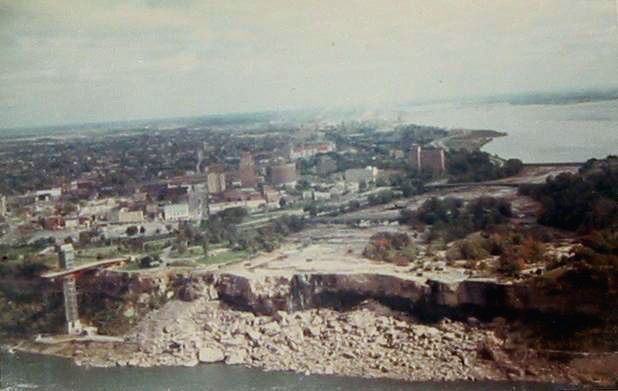 Niagara Falls Drained Dry, September 1969
Niagara Falls Drained Dry, September 1969
III. The Lincoln Memorial
I want to turn now to a more obviously human-made place that serves as a symbol of the nation, and notice the human as well as non-human forces shaping it. That place is the Lincoln Memorial in Washington, D.C. The Lincoln Memorial has a timeless and sacred quality to it and is a powerful monument to the highest of ideals: freedom, equality, respect, and tolerance—but taking a historical view shows us that both the site itself and the values it represents have never been so fixed or certain. This is a good place to think about fractals.
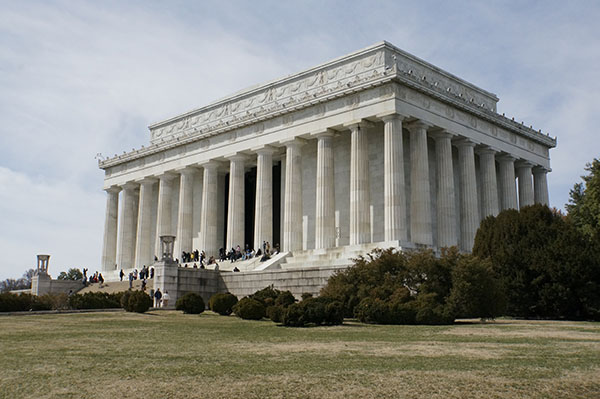 Lincoln Memorial (Photo by William Cronon)
Lincoln Memorial (Photo by William Cronon)
Let's zoom out for a minute. The Lincoln Memorial is located in Washington, D.C., a city whose original layout was created by Pierre L'Enfant. L'Enfant was a French designer who brought to his vision of D.C. a set of European design principles: a grand federal center with cleared land around it, and wide avenues linking important spaces in the capitol. This design indicated a literal imposition of power on a landscape: if you think of fuedal Europe, the cutting of straight lines through a populated landscape was only possible for individuals in positions of power. But there were problems with this vision as applied to a new republic because America, unlike some of the European ideals L'Enfant was invoking, was precisely not a monarchy. How should we indicate in the ladnscape that D.C. was a place of political power without adopting wholesale a European tradition? L'Enfant's plan tried to combine straight wide boulevards—lines of sight—with Thomas Jefferson's grid (signaling a republican vision of order, restraint, and equality). This created a city plan with both grids and axial boulevards connecting major monuments.
Once the city was laid out, L'Enfant and others who'd come after him were left with a question: in those places connected by boulevards, what should those monuments look like? What should go into a landscape that was a testament to a democratic republic?
One thing that did go into those spaces were slave markets. I say this to remind you that, lest we think D.C. is an apolitical space, it was not. An active slave trade existed in D.C. throughout the first half of the 19th century. In 1850, the year that the Compromise of 1850 outlawed slave trade in D.C. but not in the nation, a designer named Andrew Jackson Downing arrived in D.C. A landscape architect, Downing focused on the relationships of the visitors to the grounds themselves, and designed meandering paths in parks rather than grand imperial boulevards. His vision was not completely implemented, but much of what he envisioned we can see in photographs from the late 19th century.
One place we can see his effect is in the National Mall. If Niagara Falls represents the romantic sublime, the National Mall in D.C. for a period of the late 19th century begins to also exemplify a visual ideal: harmony between people and the natural world (the picturesque or the pastoral). Trees planted on the National Mall had grown up to such a point that by the 1890s, one could even see the occasional deer on the Mall: a vision of the pastoral, that ideal balance between humans and nature that we encountered in painter Thomas Cole's ideal stage in his "Course of Empire" series.
Of course, the mix of humans and nature is never just bucolic. There were on-the-ground problems: the Washington Canal became a dumping ground for trash, with waste flowing out in the Potomac River. And because of its location on low-lying land, the National Mall was subject to seasonal flooding. The 1901 McMillan Plan for D.C. responded to some of these problems, while overlooking others. The plan sited the Lincoln Memorial at the end of the National Mall, on the former mudflats that the Army Corp of Engineers had filled in with earth dredged from the Potomac River.
By 1911, a plan was finally approved for the Lincoln Memorial to be built The architect (Henry Bacon) and the sculptor (Daniel Chester French) were charged with creating the monument. For the building materials, Bacon selected Colorado Yule marble, chosen of options that were physically closer because the Colorado Yule had the white luster that Bacon sought in a stone. Noticing the building materials is just one way of remembering that the monument, though seeming timeless and pristine in its form, was a monument shaped by stone, soil, and the sweat of workers themselves. The building was sited on former mudflats, notice. So partway through construction the building started to sink into the soft, marshy ground, halting work until support structures could be drilled down into the underlying bedrock.
The building also didn't always exemplify the ideals it was meant to represent. At its opening ceremony in 1922, attendees of multiple racial backgrounds were in attendance—but those visibly Black were forced to sit in a separate, cordoned-off area. The sight was also home to a concert given by musician Marian Anderson in 1939, a Black singer who was barred from a Daughters of the American Revolution event at Constitution Hall. Perhaps the most famous way that the Lincoln Memorial has become a monument to the idea of racial equality in America is its role in hosting Reverend Martin Luther King, Jr's “I Have a Dream” speech during the 1963 March on Washington. When Dr. King stood there giving his speech, he was looking out over what had been a slave market until 1850.
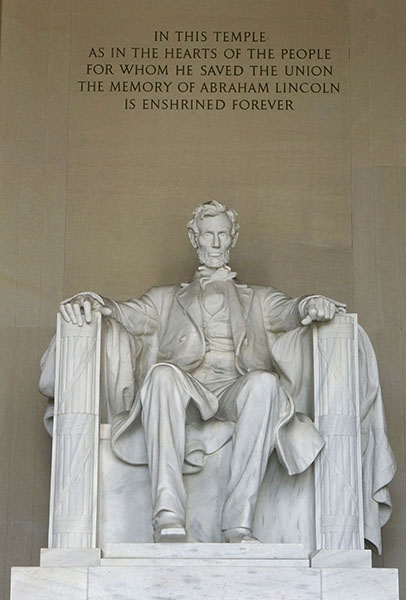 Lincoln Memorial, Abraham Lincoln Enshrined Forever
Lincoln Memorial, Abraham Lincoln Enshrined Forever
(Photo by William Cronon)
Behind the carved figure of Lincoln are chiseled these words: "In this temple as in the hearts of the people for whom he saved the Union the memory of Abraham Lincoln is enshrined forever." The Lincoln symbolized here is the Lincoln standing in for ideals of unity and emancipation, ideals depicted—again with complicated racial symbolism—in murals on the North and South Wall. Also notice the temple-like qualities of the building.
I'll close by reading Lincoln's Gettysburg Address, as a way of reminding all of us that the meaning of the nation, in Lincoln's day as in our own, is a source of contestation and debate—contestation that have produced monuments like the Lincoln Memorial and Niagara Falls.
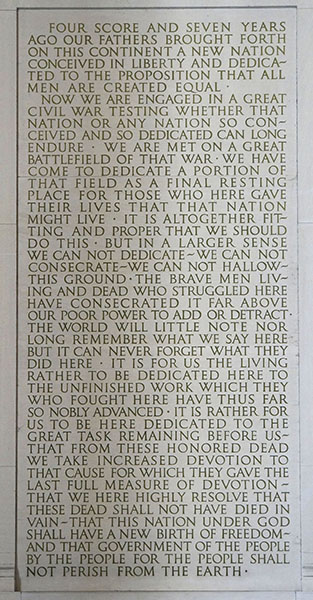 Gettysburg Address on Wall of Lincoln Memorial
Gettysburg Address on Wall of Lincoln Memorial
(Photo by William Cronon)
So, in the Lincoln Memorial, we have a landscape that retains immense symbolic power—it is impossible to visit the site and not be moved—even as it is the product of a variety of contestations and negotiations (both in the meanings of the ideals it represents and in the physical materials/landscape out of which and on which it was made). It is a symbolic space that is explicitly constructed to reflect unity and freedom as American national values, but it also exists as a document of the complex history behind its creation and interpretation.
Niagara Falls, similarly, continues to draw visitors with its capacity to instill a sense of awe (this is why “shutting off” the Falls is so remarkable). If you visit the Falls today, you can still experience an echo of what the Romantics would call the sublime; it is a “natural” space that suggests a kind of power beyond what humans can create, even though it’s been endlessly reinterpreted, harnessed for power, conquered by daredevils, and managed in order to maintain particular vantage points (like the ones in the honeymoon photos).
As these two examples (or synecdoches) indicate, both “natural” and “constructed” landscapes that resonate as American national symbols are more complicated than their representative power might initially suggest. They are the products of messy and interconnected geographies, and the cultural values they reflect—the sublime, republicanism, modernity, progress, the pastoral, unity, equality, and freedom—are continually redefined in ways that landscape history helps reveal. And yet, these landscapes continue to inspire. Thinking about why this is so is a crucial part of understanding the making of the American landscape.
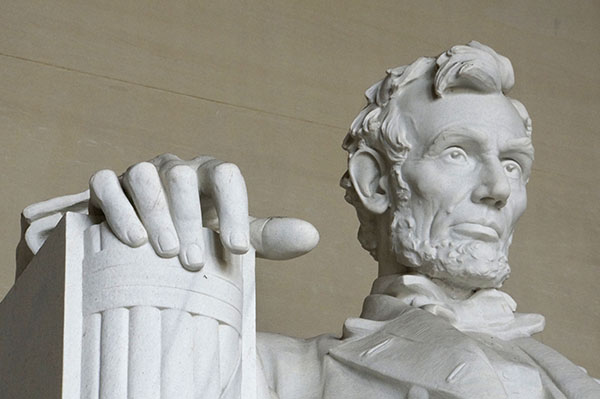 Close-Up of Abraham Lincoln Statue, Lincoln Memorial
Close-Up of Abraham Lincoln Statue, Lincoln Memorial
(Photo by William Cronon)